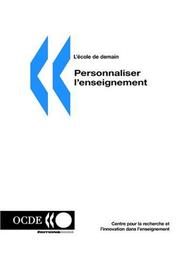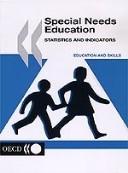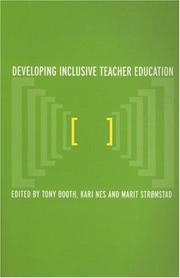| Listing 1 - 6 of 6 |
Sort by
|
Book
Year: 2021 Publisher: Washington, DC : World Bank Group,
Abstract | Keywords | Export | Availability | Bookmark
 Loading...
Loading...Choose an application
- Reference Manager
- EndNote
- RefWorks (Direct export to RefWorks)
Educational equalization. --- Special education --- Activity programs. --- Evaluation.
Book
ISBN: 1280016930 9786610016938 0585236305 Year: 1994 Publisher: Washington : World Bank,
Abstract | Keywords | Export | Availability | Bookmark
 Loading...
Loading...Choose an application
- Reference Manager
- EndNote
- RefWorks (Direct export to RefWorks)
Special education --- Children with disabilities --- Case studies. --- Education (Early childhood) --- Education (Elementary)

ISBN: 926403661X 9264036628 9789264036611 Year: 2006 Publisher: Paris: OCDE,
Abstract | Keywords | Export | Availability | Bookmark
 Loading...
Loading...Choose an application
- Reference Manager
- EndNote
- RefWorks (Direct export to RefWorks)
La personnalisation de l'éducation peut signifier maintes choses. Elle pose en outre des questions essentielles quant aux objectifs et aux possibilités de l’enseignement. À quels défis politiques faudra-t-il répondre pour favoriser un enseignement plus personnalisé ? En quoi les sciences de l’apprentissage -- et notamment les recherches récentes sur le fonctionnement du cerveau -- peuvent-elles nous éclairer quant aux orientations à prendre ? Quelles sont les contraintes imposées par les acteurs clés des systèmes éducatifs -- les enseignants, les parents et les employeurs notamment -- et comment y répondre ? Ce nouveau volume de la série « L’école de demain » répond à toutes ces questions. Il rassemble les contributions d’experts venus d’Allemagne, du Canada, du Danemark, de la France et du Royaume-Uni.
Individualized instruction. --- Enseignement individualisé --- Acqui 2006 --- Individualized instruction --- Special education --- Exceptional children --- Education --- Differentiation (Education) --- Individual instruction --- Tutors and tutoring --- Individualized education programs --- Mastery learning --- Open plan schools

ISBN: 1280030771 9786610030774 926418810X 9264176896 Year: 2000 Publisher: Paris : OECD Publishing,
Abstract | Keywords | Export | Availability | Bookmark
 Loading...
Loading...Choose an application
- Reference Manager
- EndNote
- RefWorks (Direct export to RefWorks)
This book provides a full account of a totally new approach to making international comparisons in the field of special needs education. It makes comparisons of students with disabilities, learning or behaviour difficulties and disadvantages on the basis of the additional resources made available to them to access the curriculum, which in some countries covers some 35% of school-age students. To improve the quality of the comparisons made countries re-classified their own classification schemes and data into a new tri-partite cross-national classification system:-Category A covers those students whose disabilities have clear biological causes.-Category B covers those students who are experiencing learning and behaviour difficulties for no particular reason. -Category C covers those students who have difficulties arising from disadvantages.Among the many analyses provided, the book highlights the numbers of students involved, where they are educated (special schools, special classes and regular schools), and a breakdown by gender. Data has been provided by 23 countries: Austria, Belgium (Flemish Community), Canada (New Brunswick), the Czech Republic, Denmark, Finland, France, Germany, Greece, Hungary, Ireland, Italy, Korea, Mexico, the Netherlands, New Zealand, Portugal, Spain, Sweden, Switzerland, Turkey, the United Kingdom and the United States.
Learning disabled children -- Education. --- Special education - Statistics. --- Special education. --- Children with disabilities --- Education --- Children with special educational needs --- Children with special health care needs --- Children with special needs --- Handicapped children --- Physically handicapped children --- Special needs children --- Exceptional children --- People with disabilities

ISBN: 1134412762 0203475070 1280052767 0203465237 9780203465233 0415303176 0415303184 9786610052769 661005276X 9781134412761 9780203475072 9781280052767 9781134412716 9781134412754 9780415303170 9780415303187 1134412754 Year: 2003 Publisher: London New York RoutledgeFalmer
Abstract | Keywords | Export | Availability | Bookmark
 Loading...
Loading...Choose an application
- Reference Manager
- EndNote
- RefWorks (Direct export to RefWorks)
This is the address to the Board of Governors, delivered by Mr. James D. Wolfensohn, President of the World Bank, in Hong Kong, China, on September 23, 1997. This year's core theme is the challenge of inclusion, bringing people into society who have never been part of it before, the main reason why the World Bank Group exists. On reviewing the state of development circa 1997: despite improved social indicators, the rapid rise in life expectancy levels, and freedom ascending, much still needs to be improved. In East Asia, inequities between rural, and urban areas, and between the skilled, and unskilled are becoming more widespread; in the countries of the former Soviet Union, the old, and unemployed are more vulnerable amidst the turbulence caused by the transition to market economies; in parts of Latin America, unequal access to education, and health care, and disparities in income hinder progress; and, in many of the poorest countries, population growth continues to run ahead of economic growth. Considering the challenge ahead, the message for countries is to educate "your" people; ensure their health; give them voice, and justice; strong financial systems; and, sound economic policies, recognizing the link between good economic performance, and open governance, to build the broad social consensus. The effectiveness of the development community lies in building inclusive partnerships, between the governments, and the people, involving bilateral, and multilateral assistance, as well as nongovernmental organizations, and the private sector, based on good policy environments, with a look at renewing strategies. The Bank's responsiveness to this challenge has been that of commitment to the quality of work; increased accountability to measure performance; and, improved dialogue with governments. Key strategic points of change are to mainstream social issues, increase capacity building, forge sustainable development in agriculture; promote private sector participation, and strengthen financial systems.
Inclusive education --- Special education --- Teachers --- Faculty (Education) --- Instructors --- School teachers --- Schoolteachers --- School employees --- Exceptional children --- Education --- Inclusion (Education) --- Inclusive learning --- Inclusive schools movement --- Least restrictive environment --- Mainstreaming in education --- Study and teaching (Higher) --- Training of
Book
Year: 2015 Publisher: Washington, D.C. : The World Bank,
Abstract | Keywords | Export | Availability | Bookmark
 Loading...
Loading...Choose an application
- Reference Manager
- EndNote
- RefWorks (Direct export to RefWorks)
This paper develops and estimates an equilibrium model of charter school entry and school choice. In the model, households choose among public, private, and charter schools, and a regulator authorizes charter entry and mandates charter exit. The model is estimated for Washington, D.C. According to the estimates, charters generate net social gains by providing additional school options, and they benefit non-white, low-income, and middle-school students the most. Further, policies that raise the supply of prospective charter entrants in combination with high authorization standards enhance social welfare.
Academic achievement --- Academic performance --- Academic programs --- Academic viability --- Academic year --- Achievement data --- Alternative schools --- Average class size --- Average number of children --- Black students --- Board of education --- Catholic schools --- Class size --- Classroom --- College --- Comprehensive assessment --- Cultural policy --- Culture & development --- Curricula --- Curriculum --- Early childhood --- Economics of education --- Educated parents --- Education --- Education for all --- Education reform --- Education statistics --- Education students --- Educational attainment --- Educational costs --- Effective schools --- Elementary school --- Elementary schools --- Enrollment by grade --- Enrollment data --- Ethnic composition --- Faculty --- Faculty development --- Fees --- Formula funding --- Geographic distribution --- Graduation rate --- Graduation rates --- High school --- High schools --- Knowledge --- Language curriculum --- Learning --- Literature --- Low enrollments --- Low-income students --- Middle school --- Middle school students --- Middle schools --- Ministry of education --- Net social gain --- Number of schools --- Number of students --- Open access --- Papers --- Parental income --- Partnerships in education --- Primary education --- Private school --- Private schools --- Public school --- Public school system --- Public schools --- Pupil funding --- Quality schools --- Racial segregation --- Reading --- Regular schools --- Research --- Research report --- Researchers --- School --- School attendance --- School buildings --- School climate --- School cost --- School costs --- School data --- School day --- School district --- School effectiveness --- School enrollment --- School enrolment --- School entry --- School experience --- School funding --- School leaders --- School level --- School levels --- School location --- School performance --- School principals --- School quality --- School reform --- School students --- School supply --- School survey --- School system --- School tuition --- School year --- School-age --- School-age children --- School-age population --- School-year --- Schooling --- Schools --- Science --- Secondary education --- Social science --- Social welfare --- Special education --- Student --- Student achievement --- Student body --- Student choice --- Student costs --- Student demand --- Student group --- Student groups --- Student population --- Students --- Teacher --- Teachers --- Teaching --- Teaching methods --- Tertiary education --- Tuition --- University --- Urban school --- Urban schools --- Values --- Vocational schools
| Listing 1 - 6 of 6 |
Sort by
|

 Search
Search Feedback
Feedback About UniCat
About UniCat  Help
Help News
News